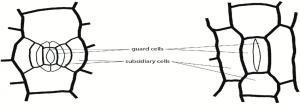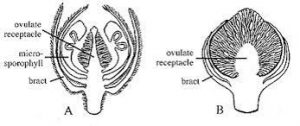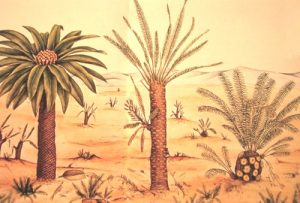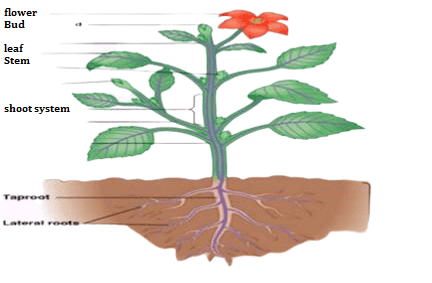Bennettitales: Introduction, Origin, Features and Affinities
Introduction and Origin of Bennettitales:
The name “Bennettitales” has been given to honor J.J. Bennett, an English botanist. This group of fossil plants flourished well during the Triassic to Lower Cretaceous periods of the Mesozoic era (ages of Cycads). Palaeobotanists believe that this group originated from Pteridospermales. Fossils of Bennettitales are found either in the form of compressions or petrifactions. Due to the Cycad-like form of their fronds and the presence of short stems covered with persistent leaf bases Bennettitale (Cycadeoideales) have been treated under Cycadophyta by some workers. Bennettitales diagram (drawn) and the fossil form discovered is shown below.


Some peculiar characteristics present in Bennettitales and not in any other group of gymnosperms include:
- (i) They bear bisporangiate strobili.
- (ii) Synangium-bearing fused microsporophylls (Triades of Sporangia).
- (iii) Close occurrence of ovules and inter-seminal scales.
- (iv) Production of stalked ovules.
Distribution
The fossilized trunk of the genus Bucklandia was the first specimen of Bennettitales, collected from Great Britain in 1825. Several well-preserved specimens have also been reported from Canada and England. Germany, Belgium, Poland, Russia, Italy, and India has long been famous fossil Cycad locality.
Features
- These were present on the earth from Triassic to Cretaceous periods.
- These were abundant during the Mesozoic era (The age of Cycads).
- Their fossil record is preserved as compressions and petrifactions.
- The stems were slender and had a wide pith.
- The Bennettitalean leaves were mostly pinnately compound, and only occasionally simple.
- They resemble much with cycads.
- Venation was open, and only rarely closed.
- Syndetocheilic type of stomata was present (Gymnosperms).

Syndetocheilic type of stomata
- The reproductive organs were organized in the form of hermaphrodite (e.g. Cycadeoidea) or unisexual (e.g. Wielandiella) “flowers”, protected by many bracts.
- The ‘flowers’ developed in the axil of leaves.
- Male reproductive organs were borne in a whorl.
- Microsporophylls sometimes surrounded megasporophylls forming hermaphrodite “flowers”.
- Ovules were numerous and stalked and borne on a conical, cylindrical, or dome-shaped receptacle.
- The scales or bracts were united at the end to form a shield through which the micropyle protrudes.
- Seeds were dicotyledonous.


Strobilus Ovules
Classification of Bennettitales:
What do you know about bennettitaceae and williansoniaceae?
They are classified into different groups by different taxonomists as under;
- Walton (1940) recognized the following two families in Bennettitales:
- Williamsonieae: Flowers are fully exposed and present on slender stems, e.g. Williamsonia. Williamsoniella and Wielandiella.
- Bennettiteae: Flowers deeply sunk among the persistent leaf bases and were present on short thick trunks e.g. Cycadeoidea

Williamsonia
- Arnold (1948) classified Bennettitales into two families
- Williamsoniaceae
- Cycadeoideaceae
- Williamsoniaceae
- Wielandiellaceae,
- Cycadeoideaceae,
Affinities of Bennettitales
This group has multiple characters which resemble different other groups of plants.
Resemblances of Bennettitales with Ferns
- Bennettitalean plants had multicellular ramenta (Thin brownish scales) on their entire body, a characteristic also seen in ferns.
- Some other features include the presence of;
- Direct leaf traces
- Scalariform tracheids
- Presence of large pith.
Resemblances of Bennettitales with Cycads
- The structure of the fronds of both groups is similar in terms of anatomical and morphological features.
- Both groups have short stems covered with persistent leaf bases.
- The stem is barrel-shaped or cylindrical.
- The presence of a very thick cortex, relatively thin wood, and large pith in the stem are the prominent features of both groups.
- Both groups have monoxylic wood (non-compact wood with a large amount of parenchyma, large pith, and cortex mixed with less amount of xylem tracheids or wood)
- Monocolpate pollen grains (pollen grains are present in monocots) are present.
- Ovules are orthotropous (straight ovules with the micropyle at the apex).

Affinities with Cycas
Resemblances of Bennettitales with Pteridospermales
- Presence of ramenta hairs.
- Syndetocheilic stomata.
- Direct leaf traces.
- Similar anatomical details.
- Leafy microsporophylls.
- Presence of cupule (A plant structure made of hardened, cohering bracts, resembling a cup).
Resemblances of Bennettitales with Gnetales
The two groups resemble each other in their seed structure but differ completely in several aspects.
According to Rodin and Kapil (1969), “the complex and highly specialized inflorescence, the presence of inter-seminal scales and some vegetative features fail to show homologies with Gnetales”.
Resemblances of Bennettitales with angiosperms
- Frequent occurrence of scalariform tracheids in both groups also brings them close together.
- Flowers of several primitive angiosperms also resemble closely the strobili of this group. It shows that are the ancestors of flowering plants.
Contrary to this,
- Ovules are naked in Bennettitales while it is not so in angiosperms.
- The wood rays of Bennettitales lack marginal cells which are present in angiosperms.
- The two groups also differ in their general habit and floral morphology.
Following is a list of characteristics of Bennettitales and Cycadales
Cycadales | Bennettitales |
|---|---|
| 1. Stomata haplocheilic. 2. Secondary wood polyxylic. 3. Traces arise as two independent units at the point of their origin. 4. Flowers are mono-sporangiate and plants are dioecious. 5. Microsporophyll’s simple with sori on lower side and arranged spirally. 6. Such an arrangement stalked ovules is not found. | 1. Stomata syndetocheilic. 2. Secondary wood monoxylic. 3. Leaf traces arise always singly at the point of their origin. 4. Flowers are bisporangiate and plants are monoecious. 5. Microsporophyll’s large, uni-or bi-pinnate, arranged in whorls and fused at the base. 6. Arrangement of stalked ovules along with inter-seminal scales. |
For more information and to get Bennettitales pdf, please visit botanylive.com
I’m Dr Qaiser Maqsood (PhD), a dedicated researcher and expert in Biological Sciences, Gardening, Bio-Diversity, Ecology, and Environmental Sciences. I’m much concerned about Environmental Pollution, Climate Change, Plantation, Gardening, and Global Warming. My passion is to explore innovative solutions in all these fields.
Be aware that we have ONLY ONE EARTH. Protect it!!






